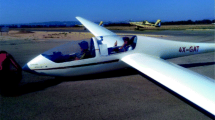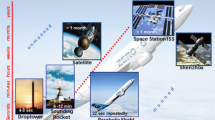Abstract
We report the results of residual acceleration obtained from initial tests of parabolic flights (more than 100 hours) performed with a small single-engine aerobatic aircraft (CAP10B), and propose a method that improves these figures. Such aircraft have proved capable of providing researchers with periods of up to 8 seconds of reduced gravity in the cockpit, with a gravity quality in the range of 0.1g 0, where g 0 is the gravitational acceleration of the Earth. Such parabolas may be of interest to experimenters in the reduced gravity field, when this range of reduced gravity is acceptable for the experiment undertaken. They have also proven to be useful for motivational and educational campaigns. Furthermore, these flights may be of interest to researchers as a test-bed for obtaining a proof-of-concept for subsequent access to parabolic flights with larger aircraft or other microgravity platforms. The limited cost of the operations with these small aircraft allows us to perform them as part of a non-commercial joint venture between the Universitat Politècnica de Catalunya - BarcelonaTech (UPC), the Barcelona cluster BAIE and the Aeroclub Barcelona-Sabadell.
Any improvements in the length and quality of reduced gravity would increase the capabilities of these small aircraft. To that end, we have developed a method based on a simulator for training aerobatic pilots. The simulation is performed with the CAD software for mechanical design Solidworks Motion\({\circledR }\), which is widely distributed in industry and in universities. It specifically simulates the parabolic flight manoeuvre for our small aircraft and enables us to improve different aspects of the manoeuvre. The simulator is first validated with experimental data from the test flights. We have conducted an initial intensive period of specific pilot training with the aid of the simulator output. After such initial simulation-aided training, results show that the reduced gravity quality has significantly improved from 0.1g 0 to 0.05g 0. We conclude that single-engine aerobatic aircraft are capable of conducting small hypogravity experiments with the limitations described in the paper.











Similar content being viewed by others
References
APEX Aircraft CAP10B flight manual: Available at: http://www.cap10c.ch/userfiles/File/HB-SBE_1000809GB_AFM_CAP10C.pdf. Accessed on 30th December 2013 (2003)
Dassault Systèmes SolidWorks Corp: Available at: http://www.solidworks.com. Accessed on 30th December 2013 (2013)
Gerke Hofmeister, P., Blum, J.: Parabolic flights @ home. Microgravity Sci. Technol. 23(2), 191–197 (2009)
Messerschmid, E., Bertrand, R.: Space Stations. Systems and Utilization. Springer, Berlin (1999)
Osborne, J. R., Alonsoperez, V., Ferrer, D., Goswami, N., Gonzlez, D., Moserm, M., Grote, V., Garcia-Cuadrado, G., Perez-Poch, A.: Effect on Mental Arithmetic on Heart Rate Responses During Parabolic Flights: The Barcelona Zero-G Challenge. Microgravity Science and Technology. In press (2014)
Pletser, V.: Short duration microgravity experiments in physical and life sciences during parabolic flights: the first 30 ESA campaigns. Acta Astronautica 55(10), 829–854 (2004)
Pletser, V., Winter, J., Duclos, F., Bret-Dibat, T., Friedrich, U., Clervoy, J.-F., Gharib, T., Gai, F., Minster, O., Sundblad, P.: The first joint european partial-g parabolic flight campaign at moon and mars gravity levels for science and exploration. Microgravity Sci. Technol. 24(6), 383–395 (2012)
Pletser, V.: Are aircraft parabolic flights really parabolic? Acta Astronautica 89, 226–228 (2013)
Rosenkopf, L., Tushman, M.: The coevolution of community networks and technology: lessons from the flight simulation industry. Ind. Corp. Change 7(2), 311–346 (1998)
Studer, M., Bradacs, G., Hilliger, A., Hrlimann, E., Engeli, S., Thiel Cora, S., Zeitner, P., Denier, B., Binggeli, M., Syburra, T., Egli, M., Engelmann, F., Ullrich, O.: Parabolic manoeuvres of the Swiss Air Force fighter jet F-5E as a research platform for cell culture experiments in microgravity. Acta Astronautica 68(11–12), 1729–1741 (2010)
Acknowledgements
Thanks are due to Dr. Nandu Goswami for his interesting comments and suggestions. We are particularly grateful to the pilots of the Aerobatic Team of Aeroclub Barcelona-Sabadell, who with their skills and dedication made these operations possible. We are also grateful to the following institutions that support this research: Universitat Politècnica de Catalunya - BarcelonaTech (UPC), the Barcelona cluster BAIE and the Aeroclub Barcelona-Sabadell. The authors would also like to acknowledge the anonymous reviewers who with their constructive comments have improved the quality of the manuscript.
Author information
Authors and Affiliations
Corresponding author
Rights and permissions
About this article
Cite this article
Brigos, M., Perez-Poch, A., Alpiste, F. et al. Parabolic Flights with Single-Engine Aerobatic Aircraft: Flight Profile and a Computer Simulator for its Optimization. Microgravity Sci. Technol. 26, 229–239 (2014). https://doi.org/10.1007/s12217-014-9382-0
Received:
Accepted:
Published:
Issue Date:
DOI: https://doi.org/10.1007/s12217-014-9382-0




